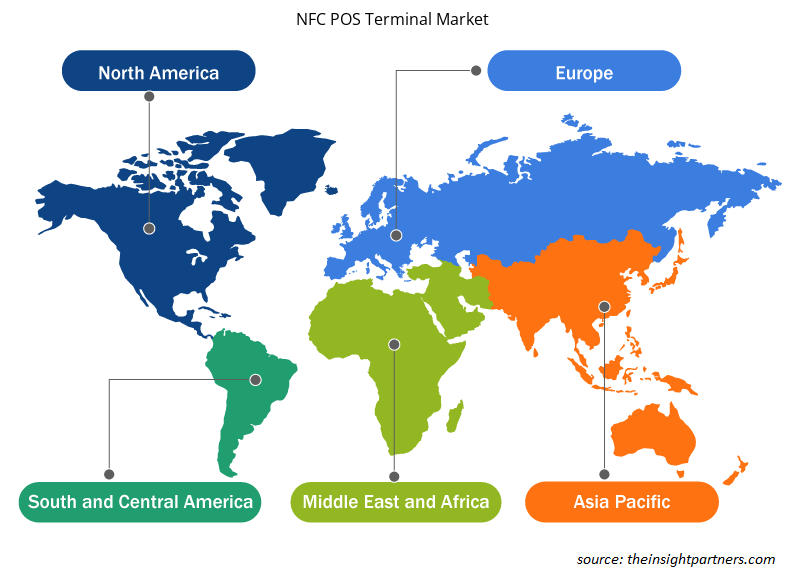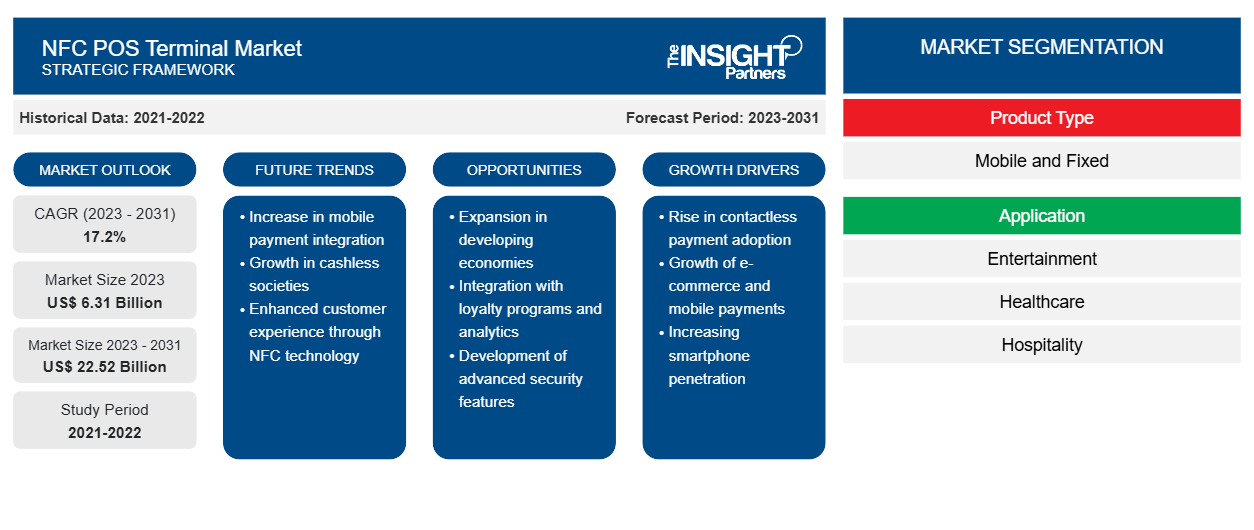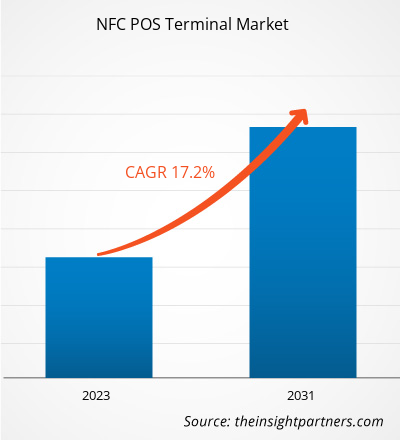Der Markt für NFC-POS-Terminals soll von 6,31 Milliarden US-Dollar im Jahr 2023 auf 22,52 Milliarden US-Dollar im Jahr 2031 wachsen; von 2023 bis 2031 wird eine durchschnittliche jährliche Wachstumsrate von 17,2 % erwartet. Der Markt wird von mehreren Faktoren angetrieben, darunter der zunehmende globale Fokus auf Digitalisierung und bargeldlose Transaktionen, die Verbreitung von NFC-fähigen Smartphones und Wearables sowie die wachsende Nachfrage nach bequemen und sicheren Zahlungsoptionen. Darüber hinaus wird der Markt durch die fortlaufende Weiterentwicklung der NFC-Technologie und ihre Integration mit anderen sich entwickelnden Technologien wie mobilen Geldbörsen und dem Internet der Dinge (IoT) in Bezug auf Funktionalität und Reichweite erweitert.
NFC-POS-Terminal-Marktanalyse
Innerhalb der größeren elektronischen Zahlungsbranche ist der NFC-POS-Markt (Near Field Communication Point of Sale) ein dynamisches Segment, das die Einführung und Nutzung der NFC-Technologie für sichere und bequeme Finanztransaktionen am Point of Sale umfasst. NFC steht für „Near Field Communication“; es handelt sich um eine Technologie, mit der zwei Geräte in unmittelbarer Nähe miteinander kommunizieren und Daten austauschen können. Damit NFC-Zahlungen funktionieren, benötigen Händler ein NFC-fähiges Point-of-Sale-/POS-System (mit WLAN) und das Smartphone oder die Karte des Verbrauchers.
Marktübersicht für NFC-POS-Terminals
- Near Field Communication (NFC) ist eine drahtlose Kommunikationstechnik, die es Geräten ermöglicht, Daten auszutauschen, wenn sie einander näher gebracht werden, normalerweise innerhalb weniger Zentimeter. In der NFC- Point-of-Sale -Branche (POS) wird diese Technologie hauptsächlich eingesetzt, um kontaktlose Zahlungsabwicklungen zu ermöglichen. Sie bietet Kunden eine effektive Möglichkeit, Transaktionen mit ihren Smartphones, Chipkarten oder anderen NFC-fähigen Geräten abzuschließen.
- Zu den wichtigsten Komponenten des NFC-POS-Marktes gehören die Infrastruktur von NFC-fähigen Zahlungsterminals, kompatiblen Mobilgeräten und das unterstützende Ökosystem aus Zahlungsdienstleistern, Finanzinstituten und Händlern. NFC-POS-Systeme basieren auf sicheren Verschlüsselungs- und Tokenisierungsprotokollen, um die Vertraulichkeit und Integrität von Zahlungsdaten zu gewährleisten und Benutzer vor betrügerischen Aktivitäten zu schützen.
Passen Sie diesen Bericht Ihren Anforderungen an
Sie erhalten kostenlose Anpassungen an jedem Bericht, einschließlich Teilen dieses Berichts oder einer Analyse auf Länderebene, eines Excel-Datenpakets sowie tolle Angebote und Rabatte für Start-ups und Universitäten.
- Holen Sie sich die wichtigsten Markttrends aus diesem Bericht.Dieses KOSTENLOSE Beispiel umfasst eine Datenanalyse von Markttrends bis hin zu Schätzungen und Prognosen.
Markttreiber für NFC-POS-Terminals
Verbreitung kontaktloser Zahlungen treibt den Markt für NFC-POS-Terminals anPOS Terminal Market
- Kontaktlose Zahlungen per NFC erfreuen sich aufgrund ihrer Geschwindigkeit, Sicherheit und Benutzerfreundlichkeit zunehmender Beliebtheit.
- Die zunehmende Beliebtheit von Wearables und Smartphones sowie das gestiegene Wissen um die Vorteile kontaktloser Zahlungen sind die Haupttreiber dieses Trends.
- Aus diesem Grund erfreuen sich NFC-Point-of-Sale-Terminals (POS) immer größerer Beliebtheit und werden vom Einzelhandel genutzt, um die Bedürfnisse der Verbraucher zu befriedigen.POS) terminals are becoming more and more common, and retailers are using them to satisfy consumer needs.
Segmentierungsanalyse des NFC-POS-Terminal-MarktberichtsPOS Terminal Market Report Segmentation Analysis
- Der Markt für NFS-POS-Terminals ist nach Produkttyp, Anwendung und Geografie unterteilt.
- Basierend auf dem Produkttyp ist der Markt in die Segmente Mobil und Festnetz unterteilt. Basierend auf der Anwendung ist der Markt in Unterhaltung, Gesundheitswesen, Gastgewerbe, Einzelhandel und Sonstige unterteilt.
- Mehrere Branchen bewegen sich in Richtung rationalisierter Transaktionsprozesse und integrieren NFC-POS-Terminals, um ihren Kunden personalisierte Lösungen anzubieten. Daher wird erwartet, dass die Nachfrage nach NFC-POS-Terminals im Prognosezeitraum steigen wird.
Marktanteilsanalyse für NFC-POS-Terminals nach geografischen Gesichtspunkten
Der Umfang des Marktes für NFC-POS-Terminals ist hauptsächlich in fünf Regionen unterteilt – Nordamerika, Europa, Asien-Pazifik, Naher Osten und Afrika sowie Südamerika. Nordamerika dominierte den Marktanteil von NFC-POS-Terminals im Jahr 2023. Nordamerika hat die höchste Verbreitung fortschrittlicher Technologien. Darüber hinaus werden positive Regierungsinitiativen und die Präsenz wichtiger Marktteilnehmer in der Region voraussichtlich das Wachstum des Marktes für NFC-POS-Terminals im Prognosezeitraum ankurbeln.
NFC-POS-Terminal
Regionale Einblicke in den NFC-POS-Terminal-Markt
Die regionalen Trends und Faktoren, die den Markt für NFC-POS-Terminals im Prognosezeitraum beeinflussen, wurden von den Analysten von Insight Partners ausführlich erläutert. In diesem Abschnitt werden auch die Marktsegmente und die Geografie von NFC-POS-Terminals in Nordamerika, Europa, im asiatisch-pazifischen Raum, im Nahen Osten und Afrika sowie in Süd- und Mittelamerika erörtert.

- Erhalten Sie regionale Daten zum NFC-POS-Terminal-Markt
Umfang des Marktberichts für NFC-POS-Terminals
| Berichtsattribut | Details |
|---|---|
| Marktgröße im Jahr 2023 | 6,31 Milliarden US-Dollar |
| Marktgröße bis 2031 | 22,52 Milliarden US-Dollar |
| Globale CAGR (2023 - 2031) | 17,2 % |
| Historische Daten | 2021-2022 |
| Prognosezeitraum | 2023–2031 |
| Abgedeckte Segmente | Nach Produkttyp
|
| Abgedeckte Regionen und Länder | Nordamerika
|
| Marktführer und wichtige Unternehmensprofile |
|
Marktteilnehmerdichte für NFC-POS-Terminals: Auswirkungen auf die Geschäftsdynamik verstehen
Der Markt für NFC-POS-Terminals wächst rasant. Dies wird durch die steigende Nachfrage der Endnutzer aufgrund von Faktoren wie sich entwickelnden Verbraucherpräferenzen, technologischen Fortschritten und einem größeren Bewusstsein für die Vorteile des Produkts vorangetrieben. Mit der steigenden Nachfrage erweitern Unternehmen ihr Angebot, entwickeln Innovationen, um die Bedürfnisse der Verbraucher zu erfüllen, und nutzen neue Trends, was das Marktwachstum weiter ankurbelt.
Die Marktteilnehmerdichte bezieht sich auf die Verteilung der Firmen oder Unternehmen, die in einem bestimmten Markt oder einer bestimmten Branche tätig sind. Sie gibt an, wie viele Wettbewerber (Marktteilnehmer) in einem bestimmten Marktraum im Verhältnis zu seiner Größe oder seinem gesamten Marktwert präsent sind.
Die wichtigsten Unternehmen auf dem Markt für NFC-POS-Terminals sind:
- Burgen Technologie Co., Ltd
- Equinox Payments LLC
- Weitere Informationen zu Clover Network, Inc.
- Heartland Payroll Solutions, Inc.
- VeriFone, Inc.
- Fiserv, Inc.
Haftungsausschluss : Die oben aufgeführten Unternehmen sind nicht in einer bestimmten Reihenfolge aufgeführt.

- Überblick über die wichtigsten Akteure auf dem NFC-POS-Terminal-Markt
Die „NFC POS-Terminal-Marktanalyse“wurde basierend auf Typ, Modus, Vertriebskanal und Geografie durchgeführt. Basierend auf dem Produkttyp ist der Markt in mobile und feste Segmente segmentiert. Basierend auf der Anwendung ist der Markt in Gesundheitswesen, Unterhaltung, Gastgewerbe, Einzelhandel und andere segmentiert. Basierend auf der Geografie ist der Markt in Nordamerika, Europa, Asien-Pazifik, den Nahen Osten und Afrika sowie Südamerika unterteilt.
Neuigkeiten und aktuelle Entwicklungen zum NFC-POS-Terminalmarkt
Unternehmen verfolgen auf dem Markt für NFC-POS-Terminals anorganische und organische Strategien wie Fusionen und Übernahmen. Einige der jüngsten wichtigen Marktentwicklungen sind unten aufgeführt:
- Im Jahr 2022 stellte XAC Automation Corporation, ein führendes F&E-/Produktionsunternehmen, das sich auf die Bereitstellung von Handelslösungen für die Zahlungsbranche konzentriert, seine neue Serie von Smart POS Terminals Platform (E6) vor, die verschiedene aktuelle Android Smart Terminals umfasst und über starke Integrations- und Konnektivitätsmöglichkeiten verfügt. Die XAC Smart POS Terminal Platform „E6“ ist mit dem sicheren Android 12-Betriebssystem ausgestattet; angetrieben von einem Quad-Core-SOC, zertifiziert mit XAC PCI PTS 6.x, für sichere Transaktionen von MSR, EMV-Chip & PIN und NFC/kontaktlosen Zahlungen. [Quelle: XAC Automation Corporation, Unternehmenswebsite]
Marktbericht zu NFC-POS-Terminals: Abdeckung und Ergebnisse
Die Marktprognose für NFC-POS-Terminals wird auf der Grundlage verschiedener sekundärer und primärer Forschungsergebnisse geschätzt, wie z. B. wichtiger Unternehmenspublikationen, Verbandsdaten und Datenbanken. Der Marktbericht „Marktgröße und Prognose für NFC-POS-Terminals (2021–2031)“ bietet eine detaillierte Analyse des Marktes, die die folgenden Bereiche abdeckt:
- Marktgröße und -prognose auf globaler, regionaler und Länderebene für alle abgedeckten wichtigen Marktsegmente.
- Marktdynamik wie Treiber, Beschränkungen und wichtige Chancen.
- Wichtige Zukunftstrends.
- Detaillierte PEST- und SWOT-Analyse
- Globale und regionale Marktanalyse, die wichtige Markttrends, wichtige Akteure, Vorschriften und aktuelle Marktentwicklungen abdeckt.
- Branchenlandschaft und Wettbewerbsanalyse, einschließlich Marktkonzentration, Heatmap-Analyse, Schlüsselakteuren und aktuellen Entwicklungen.
- Detaillierte Firmenprofile.
- Historische Analyse (2 Jahre), Basisjahr, Prognose (7 Jahre) mit CAGR
- PEST- und SWOT-Analyse
- Marktgröße Wert/Volumen – Global, Regional, Land
- Branche und Wettbewerbsumfeld
- Excel-Datensatz



Report Coverage
Revenue forecast, Company Analysis, Industry landscape, Growth factors, and Trends

Segment Covered
This text is related
to segments covered.

Regional Scope
North America, Europe, Asia Pacific, Middle East & Africa, South & Central America

Country Scope
This text is related
to country scope.
Häufig gestellte Fragen
Technological advancements and product innovation in the NFC POS terminal market are anticipated to play a significant role in the global NFC POS Terminal market in the coming years.
The major players holding majority shares in the NFC POS Terminal market are Ingenico, VeriFone, PAX Technology, NEC, and Equinox.
The growing adoption of NFC POS Terminal in the retail sector and growing awareness about contactless payment cards are the major factors that propel the global NFC POS terminal market.
The global NFC POS terminal market was estimated to grow at a CAGR of 17.2% during 2023 - 2031.
Trends and growth analysis reports related to Banking, Financial Services, and Insurance : READ MORE..
The Insight Partners performs research in 4 major stages: Data Collection & Secondary Research, Primary Research, Data Analysis and Data Triangulation & Final Review.
- Data Collection and Secondary Research:
As a market research and consulting firm operating from a decade, we have published and advised several client across the globe. First step for any study will start with an assessment of currently available data and insights from existing reports. Further, historical and current market information is collected from Investor Presentations, Annual Reports, SEC Filings, etc., and other information related to company’s performance and market positioning are gathered from Paid Databases (Factiva, Hoovers, and Reuters) and various other publications available in public domain.
Several associations trade associates, technical forums, institutes, societies and organization are accessed to gain technical as well as market related insights through their publications such as research papers, blogs and press releases related to the studies are referred to get cues about the market. Further, white papers, journals, magazines, and other news articles published in last 3 years are scrutinized and analyzed to understand the current market trends.
- Primary Research:
The primarily interview analysis comprise of data obtained from industry participants interview and answers to survey questions gathered by in-house primary team.
For primary research, interviews are conducted with industry experts/CEOs/Marketing Managers/VPs/Subject Matter Experts from both demand and supply side to get a 360-degree view of the market. The primary team conducts several interviews based on the complexity of the markets to understand the various market trends and dynamics which makes research more credible and precise.
A typical research interview fulfils the following functions:
- Provides first-hand information on the market size, market trends, growth trends, competitive landscape, and outlook
- Validates and strengthens in-house secondary research findings
- Develops the analysis team’s expertise and market understanding
Primary research involves email interactions and telephone interviews for each market, category, segment, and sub-segment across geographies. The participants who typically take part in such a process include, but are not limited to:
- Industry participants: VPs, business development managers, market intelligence managers and national sales managers
- Outside experts: Valuation experts, research analysts and key opinion leaders specializing in the electronics and semiconductor industry.
Below is the breakup of our primary respondents by company, designation, and region:

Once we receive the confirmation from primary research sources or primary respondents, we finalize the base year market estimation and forecast the data as per the macroeconomic and microeconomic factors assessed during data collection.
- Data Analysis:
Once data is validated through both secondary as well as primary respondents, we finalize the market estimations by hypothesis formulation and factor analysis at regional and country level.
- Macro-Economic Factor Analysis:
We analyse macroeconomic indicators such the gross domestic product (GDP), increase in the demand for goods and services across industries, technological advancement, regional economic growth, governmental policies, the influence of COVID-19, PEST analysis, and other aspects. This analysis aids in setting benchmarks for various nations/regions and approximating market splits. Additionally, the general trend of the aforementioned components aid in determining the market's development possibilities.
- Country Level Data:
Various factors that are especially aligned to the country are taken into account to determine the market size for a certain area and country, including the presence of vendors, such as headquarters and offices, the country's GDP, demand patterns, and industry growth. To comprehend the market dynamics for the nation, a number of growth variables, inhibitors, application areas, and current market trends are researched. The aforementioned elements aid in determining the country's overall market's growth potential.
- Company Profile:
The “Table of Contents” is formulated by listing and analyzing more than 25 - 30 companies operating in the market ecosystem across geographies. However, we profile only 10 companies as a standard practice in our syndicate reports. These 10 companies comprise leading, emerging, and regional players. Nonetheless, our analysis is not restricted to the 10 listed companies, we also analyze other companies present in the market to develop a holistic view and understand the prevailing trends. The “Company Profiles” section in the report covers key facts, business description, products & services, financial information, SWOT analysis, and key developments. The financial information presented is extracted from the annual reports and official documents of the publicly listed companies. Upon collecting the information for the sections of respective companies, we verify them via various primary sources and then compile the data in respective company profiles. The company level information helps us in deriving the base number as well as in forecasting the market size.
- Developing Base Number:
Aggregation of sales statistics (2020-2022) and macro-economic factor, and other secondary and primary research insights are utilized to arrive at base number and related market shares for 2022. The data gaps are identified in this step and relevant market data is analyzed, collected from paid primary interviews or databases. On finalizing the base year market size, forecasts are developed on the basis of macro-economic, industry and market growth factors and company level analysis.
- Data Triangulation and Final Review:
The market findings and base year market size calculations are validated from supply as well as demand side. Demand side validations are based on macro-economic factor analysis and benchmarks for respective regions and countries. In case of supply side validations, revenues of major companies are estimated (in case not available) based on industry benchmark, approximate number of employees, product portfolio, and primary interviews revenues are gathered. Further revenue from target product/service segment is assessed to avoid overshooting of market statistics. In case of heavy deviations between supply and demand side values, all thes steps are repeated to achieve synchronization.
We follow an iterative model, wherein we share our research findings with Subject Matter Experts (SME’s) and Key Opinion Leaders (KOLs) until consensus view of the market is not formulated – this model negates any drastic deviation in the opinions of experts. Only validated and universally acceptable research findings are quoted in our reports.
We have important check points that we use to validate our research findings – which we call – data triangulation, where we validate the information, we generate from secondary sources with primary interviews and then we re-validate with our internal data bases and Subject matter experts. This comprehensive model enables us to deliver high quality, reliable data in shortest possible time.


 Holen Sie sich ein kostenloses Muster für diesen Bericht
Holen Sie sich ein kostenloses Muster für diesen Bericht